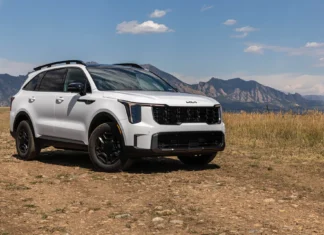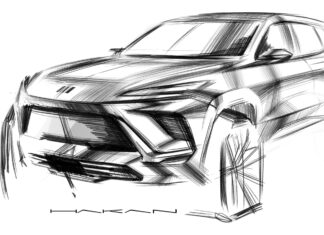
In this week’s Ask Nathan:
- Will the future Ram Power Wagon be electric?
- Should I wait for a Tesla Cybertruck?
- Got screwed by a used car dealership.
The first question has to do with the future Ram Power Wagon. It’s actually many questions/statements from different sources.
Q: (A post on a Ram Power Wagon fan site): Do you think Stellantis will make the future Ram Power Wagon all-electric?
“The future Ram Power Wagon is the last truck I would ever consider electrifying. It’s been around for 75 years and the recipe remains the same. Tough, capable, unstoppable.” – E. Berr
“Will Stellantis discontinue the Ram Power Wagon, or make it some sort of hybrid?” – C. Costa
“We will have electrified versions of every vehicle they we in the United States by 2030.” – Stellantis

A: The future Ram Power Wagon?
I’m kind of worried about Stellantis’ plans in general, to be honest. I don’t mind the idea of future electrification for many brands, but they straight-out said they will have electric versions of all of their vehicles. That’s kind of dubious for all of their heavy duty pickup trucks, to be honest.
The Ram Power Wagon is one of my favorite off-road pickup trucks. It’s not just because it is remarkably capable off-road, it simply oozes awesomeness. It’s a brute, a basher, an asphalt thug – and it’s cozy too. Sure, it laps up unleaded like a thirsty hound – it’s more frugal that the previous models. I got about 12 mpg combined driving the 2020 model… which is an improvement!

A hybrid powertrain in the Ram Power Wagon could be something…
If you think about the gains Ford and Toyota have managed by building a proper hybrid powertrain for their half-ton pickup trucks, it makes me wonder about the Power Wagon. Right now, Ram’s e-Torque system is not that efficient. Sure, there are slight gains, but it’s not exactly stellar.
The Power Wagon’s current, big-honkin’ 6.4-liter Hemi V8 makes 410 horsepower and 429 lbs-feet of torque. It moves the 7,000-lbs heavy duty truck with mucho gusto. Now, just for the purposes of comparison, the 2021 Ford F-150 Hybrid makes a combined 430 hp and 570 lb-ft of torque.
Just hang with me here.
What IF Ram made something comparable to Ford’s hybrid – but built for heavy duty trucks? Sure, there are a ton of reasons people would be resistant to this. Not the least of these issues would be concerns over complexity and reliability. Still, there are a lot of examples of both civilian and industrial hybrid systems that last a long time.
It’s just food for thought. I wonder what the folks at Stellantis are thinking.
— N
The next question comes from a Tesla fan who’s thinking about turning to Ford.

Q1: (Via: Twitter@NathanAdlen) Waiting on Tesla to make good on their Cybertruck is annoying.
I am seriously considering trading my wife’s Model 3 in for a Mach E and giving in to get a (Ford) Lightning instead of a Cybertruck. Tired of (Elon) Musk and his antics. So tired of stupid politics and game playing. Like our Model 3 and drove it over 50,000 miles in 3 years. Just hate the customer service. Kinda done.
— @OzStevensLover66
A: I hear you, and I hope it works out.
Still, there is real evidence that the Cybertruck is coming closer to production. We recently posted a story about some intriguing images and video of the Cybertruck testing. It showed many clues about the truck nearing production (mirrors, wiper, lights, etc.).
Being that I have yet to drive either the Cybertruck, or the Ford F-150 Lightning, I have no insight to share with you. On the other hand, I’ve driven both the Model 3 and Mach-E, and they are both fantastic performers. Yes, I would choose the Ford as it is a little more intuitive and I found all models to be comfy for the driver. I think the Model Y is a better competitor with the Mach-E.
Anyway, I hope it works out. Keep us in the loop!
— N

The last question comes from a friend in California who wants to know what he can do about getting screwed at a used car dealership.
Q: Just bought a 2017 Honda Pilot for $29,000. It had 70,000 miles on it.
Paid cash and got a warranty from the dealership last week. Now it’s dead and the “warranty” company won’t cover the glitch. The dealership won’t return my calls and I found a mountain of bad reviews on the place. Can you expose them!?
— Kana

A: Good news my Amigo!
Not only do you have legal avenues, you should quality under California’s used car Lemon Law requirements. Provided that you owned the vehicle for less than a month, and put less than 1,000 miles on it – the Lemon Law should apply.
I cribbed the below Lemon Law information from Douglas D. Law Esq.
Qualifying under the Lemon Law
From 2013 on, the laws of California were amended to require that even “buy here, pay here” used car dealers must offer at least a 30 day or 1,000-mile warranty that covers the essential components of the car. However, most dealers that are not “buy here, pay here” will provide a better warranty, particularly if the vehicle is Certified Pre-Owned. Either way, the Lemon Law entitles you to compensation if you bought a used car and the following qualifications are met:
- You bought the car from a retailer, not a private individual. Private used car sales are not covered under the law.
- There is an active warranty on the car, whether that is the original manufacturer’s warranty or an extended warranty given by the retailer.
- The pre-owned vehicle has a substantial defect.
- The pre-owned vehicle has spent an excessive amount of time in the shop being repaired.
- Despite a “reasonable number” of repair attempts, the car still is not fixed and the problem persist
Now, quickly reply and be prepared show up at the dealership with all of your paperwork – AND a printout of the Lemon Law. Don’t be afraid to seek legal guidance, many Lemon Law specialists do free consultations.
Finally: for all of you, make that dealership famous. There are several websites that you can report them to, including the Better Business Bureau and a variety of forums like Yelp – among others. Also, consider going to the state’s various dealerships associations, like IADAC.
Check local news sources too. You would be surprised about how many journalists are gathering data for a slam dunk on that business. On top of that, if a news piece has already posted about that dealership, contact the journalist and their editor. They are probably looking for additional material for updates and so-on.
Best of luck!
— N
p.s. Update: Kana retained an attorney and got a refund, along with additional money for expenses. Well done!
Here’s a reminder of how things can turn out.








































